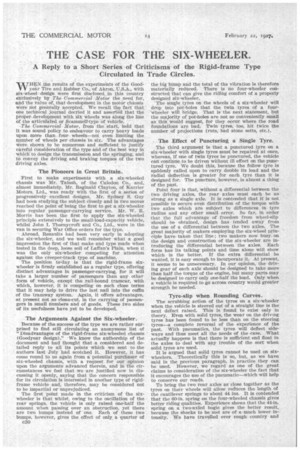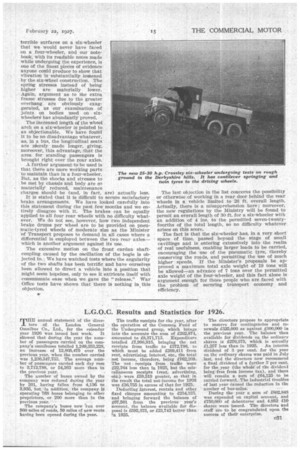THE CASE FOR THE SIX-WHEELER.
Page 52

Page 53

If you've noticed an error in this article please click here to report it so we can fix it.
A Reply to a Short Series of Criticisms of the Rigid-frame Type Circulated in Trade Circles.
WIL.H.4N the results of the experiments Of the Goodyehr Tire and Rubber Co., -of Akron,,U.S.A., with six-wheel design were first disclosed. in this country exclusively by The Commercial Motor the need for, and the value of that development in the Motor chassis were not generally accepted. We recall the fact that one technical journal decried it and asserted that the proper. developmentwith sit wheels was along the line Of the articulated or Scammell-tyPe of Vehicle. ' -The Commercial Motor, from the start, held that It was sound policy to emleavour to carry heavy loads upon more than four wheels—not even limiting the number of wheels pert chassis to six. The advantages Were shown to be numerous and sufficient to justify careful consideration of the type and of the best way in which to design the transmission and the springing, and to convey the driving and braking torques of the two driving axles.
The Pioneers in Great Britain.
First to make experiments with a six-wheeled chassis was Mr. Tainsh, of the Caledon Co., and, almost immediately, Mr. Reginald Clayton, of Karrier Motors, Ltd., was ready with the first of a series of progressively excellent designs. Mr. Sydney S. Guy had been studying the subject closely and in two moves reached the point of being the first to get a six-wheeler into regular passenger-carrying service. Mr. W. It. Morris has been the first to apply the six-wheeled principle extensively to the small-load-capacity vehicle, whilst John I. Thornycroft and Co., Ltd., were in the van in securing War Office orders for the type.
Abroad, Renaults had been very early in adopting the six-wheeler, and we well remember what a good impression the first of that make and type made when tested in the deep, loose soil of Laffan's Plain, when it was the 011iy six-wheeler competing for attention against the creeper-track type of machine.
The position to-day is that the rigid-frame sixwheeler is firmly established as a regular type, offering distinct advantages in passenger-carrying, for it will take a larger number of passengers than any other form of vehicle, except the rail-bound tramcar, with which, however, it is competing on such close terms that it may help to drive the last nail into the coffin of the tramway system. Again, it offers advantages, at present not so cleat-cut, in the carrying of passengers in small numbers and of goods. These two sides of its usefulness have yet to be developed.
The Arguments Against the Six-wheeler.
Because of the success of the type we are rather surprised to find still circulating an anonymous list of "Disadvantages of the rigid-frame six-wheeled chassis ((loodyear design)." We know the authorship of the document and had thought that a considered and detailed reply to all its points which we sent to the authors last July had scotched it. However, it has come round to us again from a potential purchaser of six-wheeled chassis, with a request for our opinion upon the arguments advanced therein, and in the circumstances we feel that we are justified now in discussing it openly, saying that the concern responsible for its circulation is interested in another type of rigidframe vehicle and, therefore, may be considered not to be impartial or unprejudiced.
The first point made in the criticism of the sixwheeler is that whilst, owing to the oscillation of the rear springs, the vehicle is only raised one-half the amount when passing over an obstruction, yet there are two bumps instead of one. Each of these two bumps, however, gives the effect of only a quarter of the big bump and the total of the vibration is therefore materially reduced. There is no four-wheeler constructed that can give the riding comfort of a properly designed six-wheeler.
The single tyres on the wheels of a six-wheeler will drop. into pot-holes that the twin tyres of a four-wheeler will bridge. That is the next statement, but the majority of pot-holes are not so conveniently small as this would suggest, for they occur, where the road foundations are bad. Twin tyres, too, hit twice the number of projections (ruts, bad stone setts, etc.).
The Effect of Puncturing a Single Tyre.
The third argument is that a punctured tyre on a six-wheeler with single tyres must be repaired at once, whereas, if one of twin tyres be punctured, the vehicle coil continue to be driven without ill effect on the punctured tyre. We doubt this, because the fellow tyre is suddenly called upon to carry double its load and the radial deflection is greater for each tyre than it is designed for. The puncture, however, is almost a thing of the past.
Point four is that, without a differential between the two driving axles, the rear axles must each be as strong as a single axle. It is contended that it is not possible to secure even distribution of the torque with two axles which are subject to differences in tyre radius and any other small error. So far, in order that the full advantage of freedom from wheel-slip should be obtained, design has tended away from the use of a differential between the two axles. The great majority of makers employing the six-wheel principle have taken that line ; two makers now busy. on the design and construction of the six-wheeler, are introducing the differential between the axles. Each form has its talking points and time alone will show which is the better. If the extra differential be wanted, it is easy enough to incorporate it. At present, it seems to be unnecessary. In our opinion, the driving gear of each axle should be designed to take more than half the torque of the engine, but many parts may be designed to carry only one-half the load. Only when a vehicle is required to go across country would greater strength be needed.
Tyre-slip when Rounding Curves.
The scrubbing action of the tyres on a six-wheeler when the vehicle is steered out of a straight line is the next defect raised. This is found to exist only in theory. Even with solid tyres, the wear on the driving tyres has been found to be less than on the steering tyres—a complete reversal of the experience of the past. With pneumatics, the tyres will deflect sideways and thus meet all the needs of the case. What actually happens is that there is sufficient end float in the axles to deal with any trouble of the sort when solid tyres are used.
It is argued that solid tyres cannot be used on sixwheelers. Theoretically this is so, but, as we have said in the previous paragraph, in practice they can be used. However, we regard as one of the great claims to consideration of the six-wheeler the fact that it encourages the use of the pneumatic—which will help to conserve our roads.
To bring the two rear axles as close together as the tyres on their wheels will allow reduces the length of the cantilever springs to about 44 ins. It is contended that the 60-in, spring on the four-wheeled chassis gives better riding qualities. Experience shows that the 44-in. spring on a two-axled bogie gives the better result, because the shocks to be met are of a--much lower intensity. We have travelled over rough country and terrible surfaces On a six-wheeler that we would never have faced on a four-wheeler, and our notebook, with its readable notes made while undergoing the experience, is one of the finest pieces of evidence anyone could produce to show that vibration is substantially lessened by the six-wheel construction. The spring stresses instead of being higher are materially lower. Again, argument as to the extra frame stresses due to the greater overhang are obviously exaggerated, as our examination of joints on bodies used on sixwheelers has abundantly proved.
The increased length of the wheel arch on a six-wheeler is pointed to as objectionable. We have found it to be no disadvantage whatever, as, in a bus, the longitudinal seats are merely made longer, giving, moreover, this advantage, that the are-a for standing passengers is brought right over the rear axles.
A further argument to be used is that there are more working parts to maintain than in a four-wheeler. But, as the shocks and stresses to be met by chassis and body are so materially reduced, maintenance charges should be (and, in fact, are) actually less.
It is stated that it is difficult to secure satisfactory brake arrangements. We have looked carefully into this statement during the past few months and we entirely disagree with it. The brakes can be equally applied to all four rear wheels with no difficulty whatever. We do not see, however, how two independent brake drums per wheel are to be provided on pneurnatic-tyred wheels of moderate size as the Minister of Transport proposes to demand in all cases where a differential is employed between the two rear axles— which is another argument against its use.
The excessive motion on the front cardan shaftcoupling Caused by the oscillation of the bogie is objected to.., We have watched tests where the angularity of the two shafts has been terrific and have ourselves been allowed to direct a vehicle into a position that might seem hopeless, only to see it extricate itself with consummate ease when we gave the " release." War Office tests have shown that there is nothing in this objection. The last objection in the list concerns the possibility or otherwise of working in a rear door behind the rear wheels in a vehicle limited to 243 ft. overall length. Actually, there is a misapprehension here; moreover, the new regulations by the Ministry will be found to permit an overall length of 30 ft. for a six-wheeler with an addition of 4 ins, to the permitted seven-twentyfourths of the total length, so no difficulty whatever arises on this score.
The fact is that the six-wheeler has, in a very short space of time, passed beyond the stage of small cavillings and is entering extensively into the realm of real usefulness, enabling larger loads to be carried, encouraging the use of the pneumatic tyre, thereby conserving the roads, and permitting the use of much higher speeds. If the -Minister's proposals be approved a maximum total axle weight of 19 tons will be allowed—an advance of 7 tons over the permitted axle weight of the four-wheeler, and this fact alone is argument enough for those people who are faced with the problem of securing transport economy and efficiency.












































































































